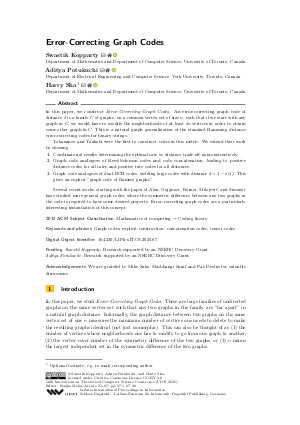Error-Correcting Graph Codes
Authors
Swastik Kopparty  ,
Aditya Potukuchi
,
Aditya Potukuchi  ,
Harry Sha
,
Harry Sha 
-
Part of:
Volume:
16th Innovations in Theoretical Computer Science Conference (ITCS 2025)
Part of: Series: Leibniz International Proceedings in Informatics (LIPIcs)
Part of: Conference: Innovations in Theoretical Computer Science Conference (ITCS) - License:
 Creative Commons Attribution 4.0 International license
Creative Commons Attribution 4.0 International license
- Publication Date: 2025-02-11
File

PDF
LIPIcs.ITCS.2025.67.pdf
- Filesize: 0.89 MB
- 20 pages
Document Identifiers
Subject Classification
ACM Subject Classification
- Mathematics of computing → Coding theory
Keywords
- Graph codes
- explicit construction
- concatenation codes
- tensor codes
Metrics
- Access Statistics
-
Total Accesses (updated on a weekly basis)
0PDF Downloads0Metadata Views
Abstract
In this paper, we construct Error-Correcting Graph Codes. An error-correcting graph code of distance δ is a family C of graphs, on a common vertex set of size n, such that if we start with any graph in C, we would have to modify the neighborhoods of at least δ n vertices in order to obtain some other graph in C. This is a natural graph generalization of the standard Hamming distance error-correcting codes for binary strings. Yohananov and Yaakobi were the first to construct codes in this metric. We extend their work by showing 1) Combinatorial results determining the optimal rate vs distance trade-off nonconstructively. 2) Graph code analogues of Reed-Solomon codes and code concatenation, leading to positive distance codes for all rates and positive rate codes for all distances. 3) Graph code analogues of dual-BCH codes, yielding large codes with distance δ = 1-o(1). This gives an explicit "graph code of Ramsey graphs". Several recent works, starting with the paper of Alon, Gujgiczer, Körner, Milojević, and Simonyi, have studied more general graph codes; where the symmetric difference between any two graphs in the code is required to have some desired property. Error-correcting graph codes are a particularly interesting instantiation of this concept.
Cite As Get BibTex
Swastik Kopparty, Aditya Potukuchi, and Harry Sha. Error-Correcting Graph Codes. In 16th Innovations in Theoretical Computer Science Conference (ITCS 2025). Leibniz International Proceedings in Informatics (LIPIcs), Volume 325, pp. 67:1-67:20, Schloss Dagstuhl – Leibniz-Zentrum für Informatik (2025)
https://doi.org/10.4230/LIPIcs.ITCS.2025.67
BibTex
@InProceedings{kopparty_et_al:LIPIcs.ITCS.2025.67,
author = {Kopparty, Swastik and Potukuchi, Aditya and Sha, Harry},
title = {{Error-Correcting Graph Codes}},
booktitle = {16th Innovations in Theoretical Computer Science Conference (ITCS 2025)},
pages = {67:1--67:20},
series = {Leibniz International Proceedings in Informatics (LIPIcs)},
ISBN = {978-3-95977-361-4},
ISSN = {1868-8969},
year = {2025},
volume = {325},
editor = {Meka, Raghu},
publisher = {Schloss Dagstuhl -- Leibniz-Zentrum f{\"u}r Informatik},
address = {Dagstuhl, Germany},
URL = {https://drops.dagstuhl.de/entities/document/10.4230/LIPIcs.ITCS.2025.67},
URN = {urn:nbn:de:0030-drops-226950},
doi = {10.4230/LIPIcs.ITCS.2025.67},
annote = {Keywords: Graph codes, explicit construction, concatenation codes, tensor codes}
}
Author Details
- Department of Mathematics and Department of Computer Science, University of Toronto, Canada
- Department of Electrical Engineering and Computer Science, York University, Toronto, Canada
Funding
- Kopparty, Swastik: Research supported by an NSERC Discovery Grant.
- Potukuchi, Aditya: Research supported by an NSERC Discovery Grant.
Acknowledgements
We are grateful to Mike Saks, Shubhangi Saraf and Pat Devlin for valuable discussions.
References
- Noga Alon. Connectivity graph-codes. arXiv preprint, 2023. URL: https://arxiv.org/abs/2308.07653.
- Noga Alon. Graph-codes. arXiv preprint, 2023. URL: https://arxiv.org/abs/2301.13305.
- Noga Alon, Anna Gujgiczer, János Körner, Aleksa Milojević, and Gábor Simonyi. Structured codes of graphs. SIAM Journal on Discrete Mathematics, 37(1):379-403, 2023. URL: https://doi.org/10.1137/22M1487989.
- Per Austrin and Subhash Khot. A Simple Deterministic Reduction for the Gap Minimum Distance of Code Problem. IEEE Transactions on Information Theory, 60(10):6636-6645, 2014. URL: https://doi.org/10.1109/TIT.2014.2340869.
- Shixi Chen and Shuigeng Zhou. Recursive mechanism: Towards node differential privacy and unrestricted joins. In Proceedings of the 2013 ACM SIGMOD International Conference on Management of Data, SIGMOD '13, pages 653-664. Association for Computing Machinery, 2013. URL: https://doi.org/10.1145/2463676.2465304.
-
Pat Devlin. Personal Communication.

-
G David Forney. Concatenated codes. Technical report, Massachusetts Institute of Technology, Research Laboratory of Electronics, 1965.

- Michael Hay, Chao Li, Gerome Miklau, and David Jensen. Accurate Estimation of the Degree Distribution of Private Networks. In 2009 Ninth IEEE International Conference on Data Mining, pages 169-178, 2009. URL: https://doi.org/10.1109/ICDM.2009.11.
- Palak Jain, Adam Smith, and Connor Wagaman. Time-Aware Projections: Truly Node-Private Graph Statistics under Continual Observation. arXiv, 2024. URL: https://doi.org/10.48550/arXiv.2403.04630.
- J. Justesen. Class of constructive asymptotically good algebraic codes. IEEE Transactions on Information Theory, 18(5):652-656, 1972. URL: https://doi.org/10.1109/TIT.1972.1054893.
- Shiva Prasad Kasiviswanathan, Kobbi Nissim, Sofya Raskhodnikova, and Adam Smith. Analyzing graphs with node differential privacy. In Proceedings of the 10th Theory of Cryptography Conference on Theory of Cryptography, TCC'13, pages 457-476. Springer-Verlag, 2013. URL: https://doi.org/10.1007/978-3-642-36594-2_26.
-
James L Massey. Threshold decoding. Technical report, Massachusetts Institute of Technology, Research Laboratory of Electronics, 1963.

- M. Plotkin. Binary codes with specified minimum distance. IRE Transactions on Information Theory, 6(4):445-450, 1960. URL: https://doi.org/10.1109/TIT.1960.1057584.
- I. S. Reed and G. Solomon. Polynomial Codes Over Certain Finite Fields. Journal of the Society for Industrial and Applied Mathematics, 8(2):300-304, 1960. URL: https://doi.org/10.1137/0108018.
- Kai-Uwe Schmidt. Symmetric bilinear forms over finite fields with applications to coding theory. Journal of Algebraic Combinatorics, 42(2):635-670, 2015. URL: https://doi.org/10.1007/s10801-015-0595-0.
- W.M. Schmidt. Equations over Finite Fields: An Elementary Approach. Lecture Notes in Mathematics. Springer Berlin Heidelberg, 2006. URL: https://books.google.co.uk/books?id=up97CwAAQBAJ.
- J. Wolf. On codes derivable from the tensor product of check matrices. IEEE Transactions on Information Theory, 11(2):281-284, 1965. URL: https://doi.org/10.1109/TIT.1965.1053771.
- Lev Yohananov, Yuval Efron, and Eitan Yaakobi. Double and Triple Node-Erasure-Correcting Codes Over Complete Graphs. IEEE Transactions on Information Theory, 66(7):4089-4103, 2020. URL: https://doi.org/10.1109/TIT.2020.2971997.
- Lev Yohananov and Eitan Yaakobi. Codes for Graph Erasures. IEEE Transactions on Information Theory, 65(9):5433-5453, 2019. URL: https://doi.org/10.1109/TIT.2019.2910040.
